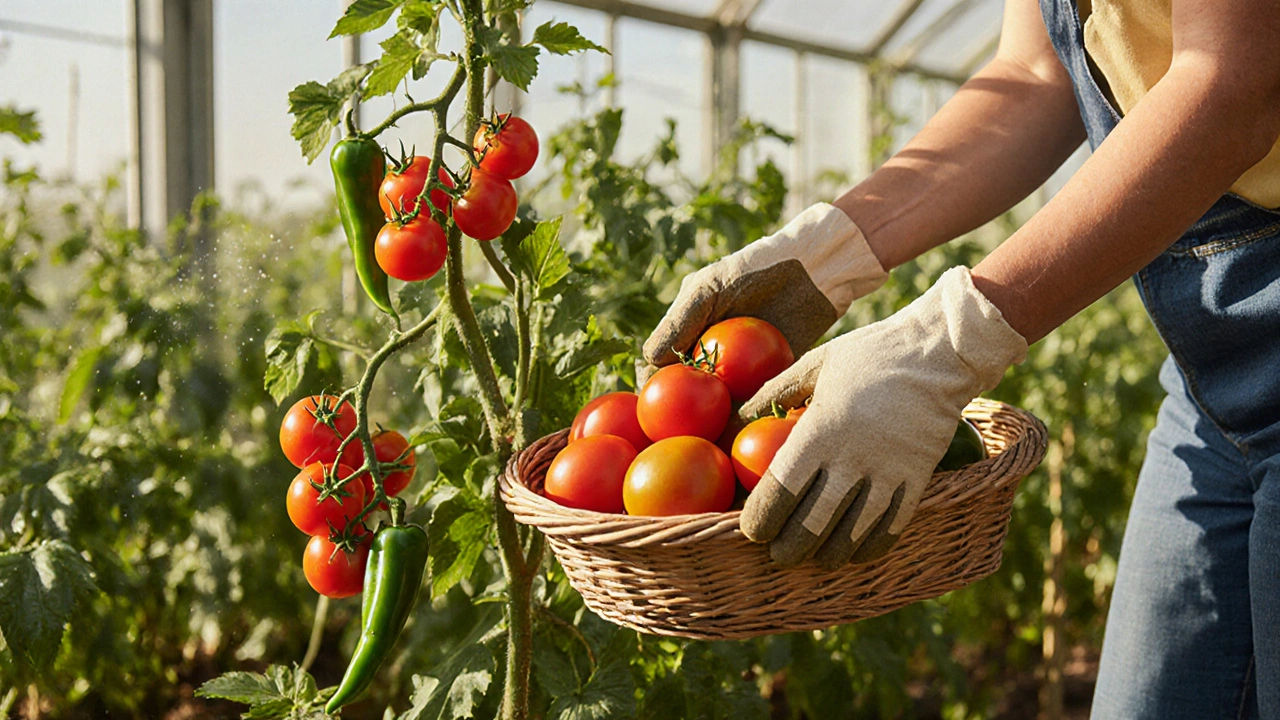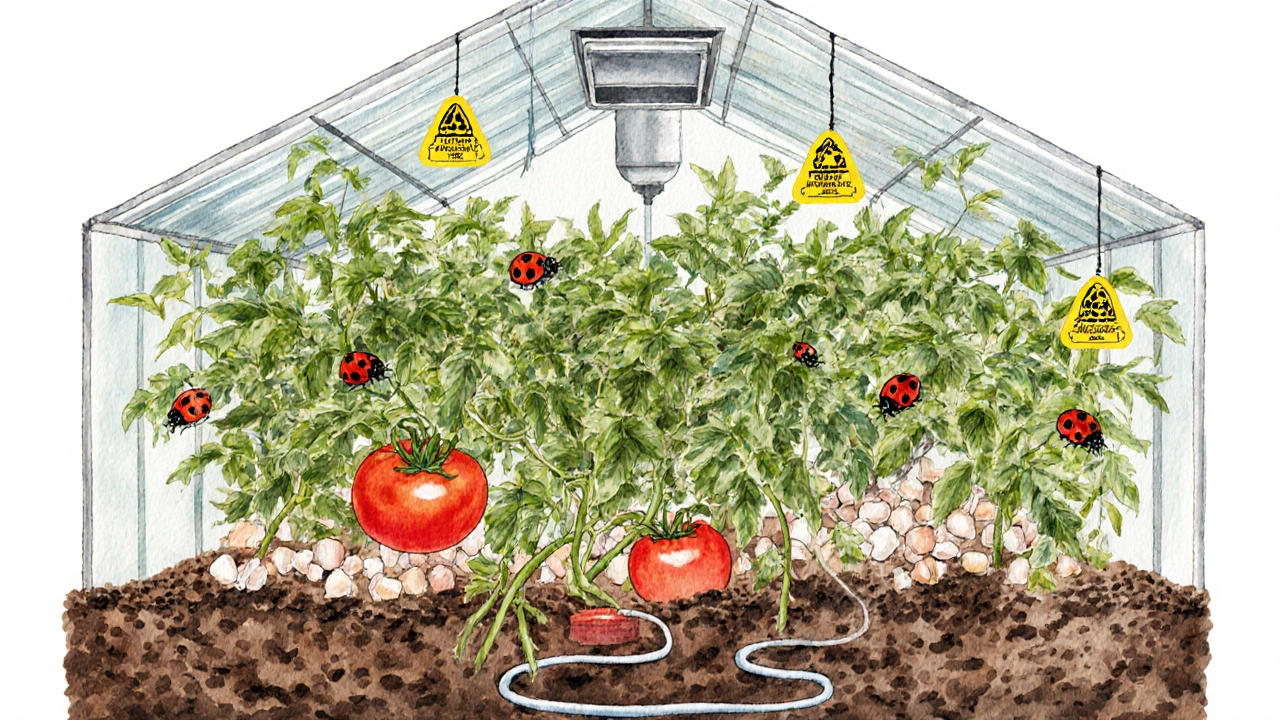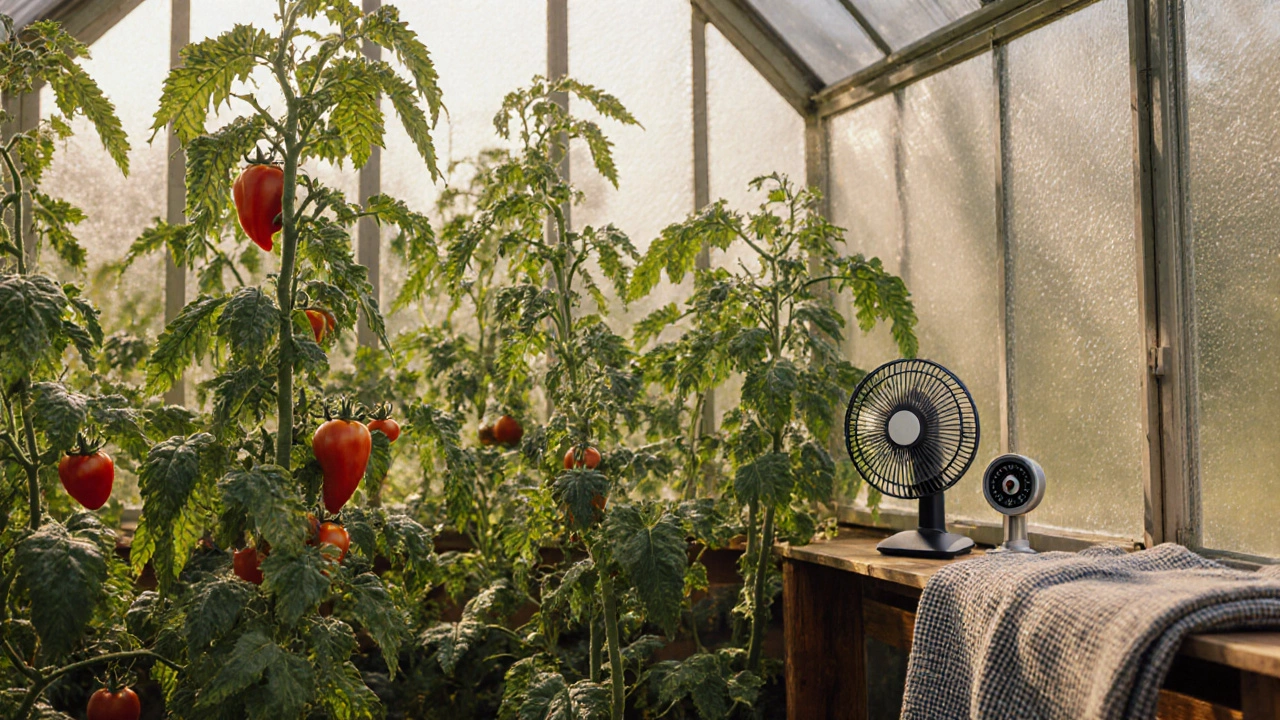Greenhouse Space Planner
Optimize Your Greenhouse Space
Calculate how many tomato and pepper plants fit in your greenhouse while maintaining optimal spacing. Based on UK growing guidelines from the article.
Tomatoes
Max Plants:
Required Space: m²
Peppers
Max Plants:
Required Space: m²
Important UK Greenhouse Tips
• Tomatoes: Need 75cm spacing for cordon varieties
• Peppers: Must have at least 6 hours of sunlight
• Humidity: Keep below 70% to prevent disease
• Place tomatoes on north side to avoid shading peppers
Many UK gardeners wonder if tomatoes and peppers can share the same greenhouse. The short answer? Yes - and they often thrive better together than apart. But it’s not just about cramming them into the same space. Success comes from matching their needs, managing space wisely, and avoiding common mistakes that lead to disease or poor yields.
Why Tomatoes and Peppers Are a Natural Pair
Both tomatoes and peppers are members of the Solanaceae family. That means they share similar growing habits, temperature needs, and pest vulnerabilities. In a UK greenhouse, this alignment makes them ideal partners. You’re not forcing two incompatible plants together - you’re creating a habitat that suits both.
They both love warmth. Daytime temperatures between 21°C and 27°C are perfect. At night, they don’t like it below 16°C. If your greenhouse dips below that, you’ll see slow growth, flower drop, or even frost damage - especially in early spring or late autumn. In Brighton, where winters are mild but damp, a small heater and thermal blanket can make all the difference.
They also need the same thing from the soil: well-drained, rich in organic matter, and slightly acidic (pH 6.0-6.8). If you’ve got your tomato compost sorted, your peppers will thank you.
Space Planning: Don’t Let Them Crowd Each Other
Here’s where most people go wrong. They plant tomatoes and peppers too close, thinking, “They’re both tall, so they’ll be fine.” But tomatoes grow fast and bushy. Without room, they’ll shade out peppers, block airflow, and create a humid mess that invites blight.
Give each plant at least 45-60 cm of space between stems. For cordon (indeterminate) tomatoes, leave 75 cm between rows. Peppers - especially varieties like ‘Cayenne’ or ‘Bell Boy’ - don’t need as much width but still need breathing room. Use trellises or stakes for tomatoes so they grow upward, not outward. This keeps the lower leaves of peppers exposed to light and air.
Place taller tomatoes on the north side of the greenhouse (in the Northern Hemisphere), so they don’t cast shadows on the peppers. Peppers do fine with partial shade, but they still need at least 6 hours of direct sunlight daily. If your greenhouse gets less than that, consider grow lights for the pepper section.
Watering: One Rule for Both
Both plants hate wet feet. Overwatering is the #1 killer of greenhouse peppers and tomatoes. Let the top 2-3 cm of soil dry out between waterings. When you do water, soak the root zone - don’t just sprinkle the leaves. Wet leaves in a humid greenhouse = perfect conditions for fungal diseases like botrytis and powdery mildew.
Use drip irrigation or water at the base with a long-spouted can. Water in the morning so leaves dry off before nightfall. In cooler months, reduce frequency. A tomato plant in March doesn’t need daily water like it does in July.
Pro tip: Place a small hygrometer in the greenhouse. If humidity stays above 70% for long, open vents or use a small fan. Even a cheap USB fan on a timer helps circulate air and reduces disease risk.
Feeding: Same Food, Different Timing
Both plants are heavy feeders, but they need different nutrients at different times. Start both with a balanced fertilizer (like 10-10-10) when transplanting. Once tomatoes start flowering, switch to a high-potash feed - tomato feed works perfectly. Peppers also benefit from extra potassium, but they don’t need it as early.
Wait until peppers have set their first fruit before boosting potassium. Too much too soon can lead to blossom end rot in peppers - a calcium deficiency that looks like black, sunken spots on the bottom of the fruit. To prevent this, mix crushed eggshells into the soil at planting or use a calcium-rich liquid feed every 2-3 weeks.
Don’t over-fertilise. Yellowing leaves or burnt leaf edges mean you’ve gone too far. Flush the soil with plain water if you suspect fertilizer burn.

Pest and Disease Management: Shared Risks, Shared Solutions
Whiteflies, aphids, and spider mites love both tomatoes and peppers. They’re not picky. The best defence? Prevention.
Hang yellow sticky traps from the top of the greenhouse - they catch whiteflies and thrips before they multiply. Introduce beneficial insects like ladybugs or lacewings if you’re growing organically. You can buy them online from UK suppliers like Buglife or GreenCure.
Watch for early signs of blight - brown spots on leaves, followed by black stems. If you see it, remove affected leaves immediately. Don’t compost them - bag them and bin them. Disinfect your tools with a 10% bleach solution after pruning. Blight spreads fast in damp, warm conditions.
Peppers are more prone to blossom drop if temperatures swing too much. Keep the greenhouse stable. A simple thermostat-controlled vent opener costs under £30 and can save your crop.
Harvesting: Timing Matters
Tomatoes ripen faster than peppers. You might start harvesting ripe tomatoes in late June if you planted in April. Peppers take longer - expect your first sweet peppers in late July or early August. Hot peppers like ‘Jalapeño’ or ‘Thai Dragon’ can take even longer.
Don’t wait for peppers to turn red if you prefer them green. Most varieties are edible and flavorful at any stage. Just be gentle when picking - the stems are brittle. Use secateurs, not your fingers.
Harvest tomatoes when they’re fully coloured but still slightly firm. Leave them on the vine as long as possible for the best flavour. If frost threatens in October, pick all green tomatoes and ripen them indoors on a windowsill.
What Doesn’t Work: Common Mistakes
- Planting too early - Don’t put them in before mid-April unless you have heated propagation. Cold soil kills roots.
- Using the same pots for both - If you reuse pots without sterilising, you risk carrying over soil-borne diseases like verticillium wilt.
- Ignoring ventilation - A sealed greenhouse in July is a death trap. Open roof vents, side windows, and use fans.
- Overcrowding - More plants ≠ more yield. Thin out if needed. One healthy plant beats three struggling ones.

Best Varieties for UK Greenhouses
Not all tomatoes and peppers are created equal. Stick to varieties bred for UK conditions.
Tomatoes:
- ‘Alicante’ - Reliable, sweet, great for beginners
- ‘Sungold’ - Sweet cherry type, prolific, hard to grow without
- ‘Ailsa Craig’ - Classic beefsteak, good disease resistance
Peppers:
- ‘Cayenne’ - Hot, productive, thrives in heat
- ‘Bell Boy’ - Sweet, compact, great for small spaces
- ‘Lipstick’ - Orange-red, early maturing, beautiful in salads
These varieties have been tested in UK greenhouses for over a decade. They handle our unpredictable springs and cool autumns better than tropical hybrids.
Next Steps: What to Do After Harvest
Once your last tomato is picked, don’t just pull everything out. Remove all plant debris - roots and all. Solarise the soil: cover it with clear plastic for 3-4 weeks in late autumn. The sun heats the soil to over 50°C, killing pests and pathogens.
Then, add compost or well-rotted manure. Let the soil rest over winter. In February, test the pH again. Adjust if needed. By March, you’ll be ready to start new seedlings - maybe even try eggplants or okra next year. They like the same conditions.
Can I grow tomatoes and peppers together in a small greenhouse?
Yes, but space matters. Even in a 2m x 3m greenhouse, you can grow 4-6 tomato plants and 6-8 pepper plants if you train tomatoes vertically and leave room for airflow. Use trellises, avoid overcrowding, and monitor humidity closely.
Do tomatoes and peppers cross-pollinate?
No. They’re both self-pollinating and won’t cross-pollinate with each other. You can safely grow them side-by-side without worrying about your peppers turning spicy or your tomatoes tasting like chilli. Bees and wind won’t cause cross-pollination between these two species.
Why are my pepper plants not fruiting?
Poor pollination, cold nights, or too much nitrogen are the usual causes. Gently shake the plants midday to help pollen move. Keep nighttime temps above 16°C. And stop feeding with high-nitrogen fertilisers once flowers appear - switch to potash-rich tomato feed.
Should I use the same compost for both?
Yes - a good quality peat-free tomato compost works perfectly for both. Just make sure it’s well-draining. If your compost holds too much water, mix in perlite or coarse sand (1 part to 3 parts compost).
When should I start seeds for tomatoes and peppers in the UK?
Start seeds indoors in late February or early March. Use a propagator with bottom heat (21-24°C). Transplant into individual pots after 4-6 weeks. Move them into the greenhouse after the last frost - usually mid-to-late April in southern England. Don’t rush it.
Final Thought: It’s About Harmony, Not Competition
Growing tomatoes and peppers together isn’t just practical - it’s efficient. You save space, water, and time. You also create a mini ecosystem where one plant supports the other. Tomatoes help shade peppers from harsh midday sun. Peppers attract pollinators that also visit tomato flowers.
The key is balance. Match their needs, give them room, and respect their rhythms. If you do, you’ll harvest more - and enjoy it longer - than if you grow them separately.
